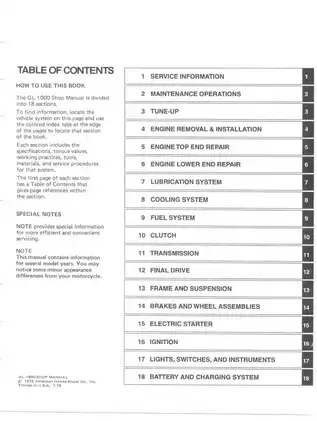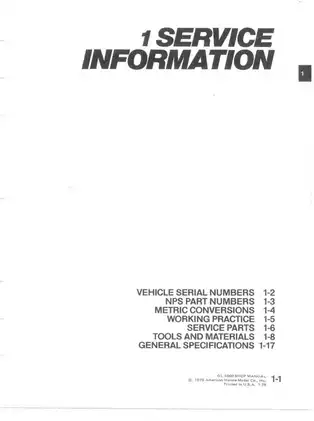Maintenance Manual: Honda GL 1000 Gold Wing (1975-1979)
Product Gallery

Sample pages from the Maintenance Manual: Honda GL 1000 Gold Wing (1975-1979) manual



Purchase Information
1975-1979 Honda GL 1000 Gold Wing Shop Manual - Technical Specifications
- Document Number / Seller:
- 24429 / Kenneth Diaz
- File Size:
- 41.59 MB
- File Type:
- Language:
- English (some of our manuals are multilanguage)
- Pages:
- 327
- Printable:
- Yes
- Estimated Download Time:
- 0.85 Minutes
- Delivery Format:
- Digital (PDF) - Instant Access
- Category:
- Motorcycle
- Brand:
- Honda
- Reviewed and Approved:
- Sep 3, 2025
Honda Models and Parts Covered in this Motorcycle Manual
- GL 1000 (1975-1979)
- Gold Wing
Complete Manual Information
Honda GL 1000 Gold WingShop Manual, covers 1975-1979
The Honda GL 1000 Gold Wing Shop Manual is your comprehensive guide to maintaining and servicing your motorcycle effectively. Designed specifically for the 1975-1979 model years, this manual covers vital information that every GL 1000 Gold Wing owner should have to keep their motorcycle in peak condition.
Key Features:
- Thorough Coverage of Maintenance Operations: The manual is divided into 18 detailed sections, ensuring you can find the information you need quickly and efficiently.
- Service Information & Specifications: Includes essential specifications, torque values, and detailed service procedures to guide you through every repair.
- Detailed Troubleshooting Guidelines: Navigate issues effectively with easy-to-follow troubleshooting advice.
- Clear Index and Navigation: Utilize the colored index tabs for easy access to any section of the manual, making it user-friendly for both novice and experienced mechanics.
What's Inside
Table of Contents
- Service Information
- Maintenance Operations
- Tune-Up Procedures
- Engine Removal & Installation
- Engine Top and Lower End Repair
- Lubrication and Cooling Systems
- Electrical Starter, Ignition, and Lights
- Transmission and Clutch
- Frame, Suspension, and Final Drive
- Battery and Charging System
- Special Notes and Service Parts
- Tools and Materials
- General Specs
- Troubleshooting Guides
- Metric Conversions
This manual is your essential companion for ensuring the longevity and performance of your Honda GL 1000 Gold Wing motorcycle. With detailed illustrations and clear instructions, you can perform maintenance like a pro!
Download Instructions for Honda Motorcycle Manual
Frequently Asked Questions - Honda Motorcycle Manual
What does this Honda manual cover?
This comprehensive service manual covers detailed repair procedures, maintenance schedules, troubleshooting guides, and technical specifications for Maintenance Manual: Honda GL 1000 Gold Wing (1975-1979). It includes information for the following models: - GL 1000 (1975-1979) - Gold Wing.
Is this manual suitable for beginners?
Yes, this Honda manual is designed for both professional technicians and DIY enthusiasts. It includes step-by-step procedures with clear illustrations and safety guidelines for Motorcycle maintenance and repair.
What file format will I receive?
You will receive this manual as a PDF file (41.59 MB), which is compatible with all devices. The manual is fully searchable and printable for your convenience.
How quickly can I access the manual after purchase?
You'll receive instant access to your Honda Motorcycle manual immediately after payment completion. The download link is valid for 3 days, with lifetime re-download guarantee.
Are engine specifications included?
This motorcycle service manual includes detailed engine specifications, valve clearances, torque settings, and performance data specific to your Honda model.
Can I print specific sections of the manual?
Absolutely! This digital manual allows you to print any section you need, from individual pages to complete chapters, making it perfect for workshop use.
Customer Reviews and Feedback
Read what our customers say about this Honda Motorcycle manual and share your own experience.
Add Comment
This policy contains information about your privacy. By posting, you are declaring that you understand this policy:
- Your name, rating, website address, town, country, state and comment will be publicly displayed if entered.
- Aside from the data entered into these form fields, other stored data about your comment will include:
- Your IP address (not displayed)
- The time/date of your submission (displayed)
- Your email address will not be shared. It is collected for only two reasons:
- Administrative purposes, should a need to contact you arise.
- To inform you of new comments, should you subscribe to receive notifications.
- A cookie may be set on your computer. This is used to remember your inputs. It will expire by itself.
This policy is subject to change at any time and without notice.
These terms and conditions contain rules about posting comments. By submitting a comment, you are declaring that you agree with these rules:
- Although the administrator will attempt to moderate comments, it is impossible for every comment to have been moderated at any given time.
- You acknowledge that all comments express the views and opinions of the original author and not those of the administrator.
- You agree not to post any material which is knowingly false, obscene, hateful, threatening, harassing or invasive of a person's privacy.
- The administrator has the right to edit, move or remove any comment for any reason and without notice.
Failure to comply with these rules may result in being banned from submitting further comments.
These terms and conditions are subject to change at any time and without notice.
Comments (2)